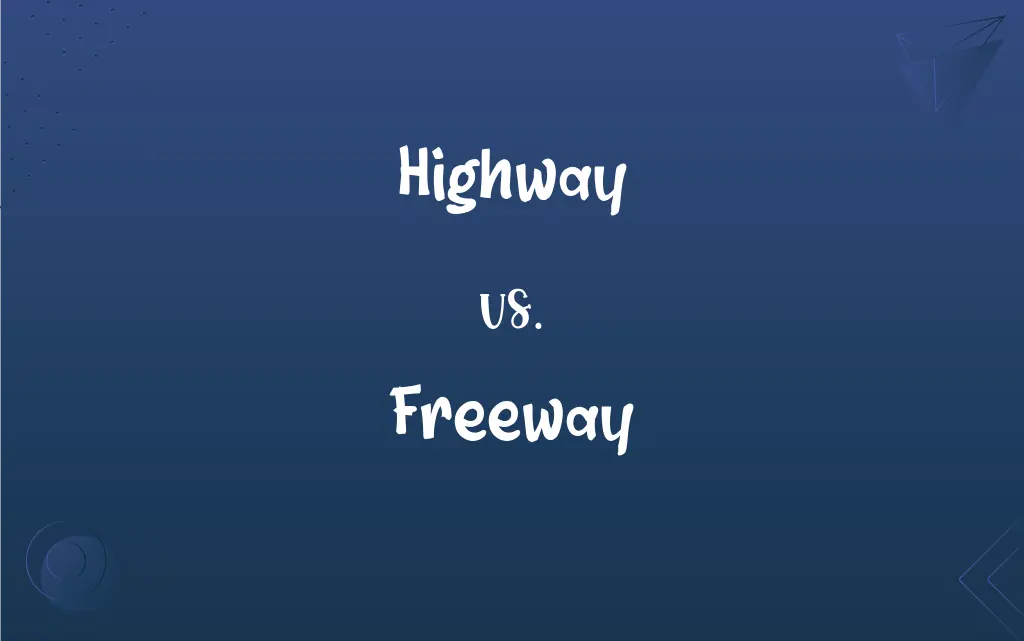Highway vs. Freeway: What's the Difference?
Edited by Aimie Carlson || By Harlon Moss || Updated on October 8, 2023
Highway and freeway both refer to major roads, but a freeway is typically a toll-free, restricted-access highway, while a highway can be any major road, often with traffic lights and intersections.

Key Differences
Highway represents a major public road that can accommodate vehicles traveling between cities or towns. Fundamentally, highways are significant routes that facilitate transport and communication across various regions. On the highway, intersections, traffic signals, and sometimes pedestrian access are commonplace, permitting varied types of vehicular and sometimes non-vehicular movement. Occasionally, highways may demand toll fees, or alternatively, some might be free to utilize, enhancing their ubiquity and functional accessibility in different contexts.
Freeway, meanwhile, symbolizes a particular type of highway that provides unbridled and continuous flow of vehicles without the intervention of traffic lights and intersections. Freeways assure a streamlined, swift, and generally, an unimpeded transit experience, as they characteristically disallow non-motorized traffic and prohibit direct property access. Typically, these are designed with wider lanes, ample shoulder areas, and employ controlled-access points or interchanges, substantiating a systematic, and oftentimes, speedier traverse through urban and interurban realms.
Highways can encompass various road types within them and are inclusive of different kinds of roads, including freeways. These prominent routes, irrespective of their size, are fundamental in connecting cities, towns, and even countries, with their nature, functionality, and regulations being defined by the respective local or federal authorities. A single highway can exhibit differing characteristics along its length, proffering a mutable transit environment that might alternately prioritize speed, accessibility, or even scenic enjoyment, depending on the specific region or sector.
Freeways confer an express and high-speed transit experience, with design and regulation expressly mitigating potential interruptions or slowdowns. These routes are especially essential in metropolises and densely populated areas, as they facilitate swift intercity and intracity mobility, thereby becoming critical arteries that pulse with incessant vehicular life. The functional absence of intersections, traffic signals, and the rigorous regulation of access points mitigate congestion, streamline traffic flow, and usually enable higher speed limits, facilitating comparatively expedited journeys.
Highways, being inclusive of a diverse array of road types, demonstrate remarkable variability in their physical and functional characteristics. Depending on geographic, demographic, and administrative contexts, highways can demonstrate vastly divergent features, like lane width, speed limits, and permissible vehicle types, affirming their position as versatile conduits that cater to varied transit needs, preferences, and situations. Freeways invariably emanate a consistent commitment to speed and efficiency, but highways, in their inclusivity and variability, embody a wider spectrum of transit philosophies and experiences.
ADVERTISEMENT
Comparison Chart
Access
Can have intersections and direct access to properties.
No intersections; access is controlled via ramps and interchanges.
Tolls
Can be toll-free or have tolls.
Typically toll-free.
Traffic Lights
May have traffic lights.
No traffic lights.
Vehicle Types
Might allow various types of vehicles, including bicycles.
Restricted to motorized vehicles.
Speed Limits
Variable speed limits, often lower than freeways.
Consistently high speed limits due to controlled access.
ADVERTISEMENT
Highway and Freeway Definitions
Highway
Highways can be either toll roads or toll-free, depending on jurisdiction and funding.
Travelers often choose the highway despite the tolls due to its more direct route.
Freeway
Freeways are typically designed for longer-distance travel and may span across multiple cities or states.
The freeway connects three states, offering an uninterrupted journey for hundreds of miles.
Highway
Highways can encompass various road types, including boulevards, expressways, and freeways.
The highway transitions from a freeway in the countryside to an expressway in the city.
Freeway
The freeway usually prohibits non-motorized vehicles and pedestrian traffic, ensuring smooth flow.
Bicyclists are not allowed on the freeway to maintain consistent high-speed vehicular movement.
Highway
Highways can sometimes permit various vehicle types, including cars, bicycles, and pedestrians.
The coastal highway allows bicycles, providing a scenic route for cyclists and motorists alike.
Freeway
On freeways, vehicles enter and exit through designated ramps, eliminating direct-access points.
The freeway's exit ramps safely guide vehicles off the high-speed lanes to their desired exits.
Highway
A highway is a major road intended for traveling between cities and towns.
The highway connects several small towns, facilitating trade and travel between them.
Freeway
A freeway is a high-speed, divided highway with fully controlled access and no traffic signals.
The freeway enables rapid transit between cities due to the absence of traffic signals.
Highway
Highways can have intersections, traffic lights, and sometimes pedestrian crossings.
The highway through the city becomes busy with numerous traffic lights and pedestrian crossings.
Freeway
Freeways are often toll-free, funded by governmental entities to facilitate unhindered travel.
Residents prefer the freeway for intercity travel since it doesn’t require paying tolls.
Highway
A main public road, especially one connecting towns and cities.
Freeway
See expressway.
Highway
(historical) A road that is higher than the surrounding land and has drainage ditches at the sides
FAQs
Can highways have toll points?
Yes, some highways may require tolls, while others might be toll-free.
What is a highway?
A highway is a major public road that may include various types of roadways and can connect cities and towns.
Are bicycles allowed on freeways?
Generally, no. Freeways restrict access to motorized vehicles.
Can a freeway have pedestrian crossings?
No, freeways prohibit pedestrian crossings to maintain continuous vehicle flow.
What's the primary purpose of a freeway?
The freeway's primary purpose is to allow for rapid, uninterrupted vehicular travel across significant distances.
What's the design focus of a highway?
Highways focus on connecting regions and may balance speed, accessibility, and sometimes, scenic value.
Are traffic jams common on freeways?
While designed for smooth flow, freeways can experience traffic jams, often due to high volume or accidents.
How does a freeway differ from a highway?
A freeway is a type of highway with controlled access, no traffic signals, and typically no tolls, ensuring high-speed travel.
Do highways always have high-speed limits?
Not always. Highways can have variable speed limits, sometimes lower, especially through populated areas.
Can a road be both a highway and a freeway?
Yes, a freeway is a type of highway, so a road can be both.
How are highways and freeways maintained?
Maintenance is usually handled by governmental transportation agencies, funded through various means, including tax and toll revenues.
Can you find traffic lights on a freeway?
No, freeways do not have traffic lights but employ ramps and interchanges for vehicle entry and exit.
Are all freeways multi-lane?
Most freeways have multiple lanes to accommodate high volumes of traffic and ensure smooth flow.
Are service areas common on freeways?
Yes, freeways often have service areas providing amenities like food and fuel for travelers.
Can highways have residential access?
Yes, some highways permit direct property access, especially in non-freeway sections.
Can a highway run through a city?
Yes, highways can traverse through cities, often having intersections and traffic signals.
What vehicles are restricted on a freeway?
Non-motorized vehicles, like bicycles, and pedestrians are typically restricted on freeways.
How are highways funded?
Highways can be funded through various means, such as federal, state, or local funds, and possibly tolls.
Do all highways facilitate long-distance travel?
While highways often connect distant regions, some may facilitate shorter, more local travel.
Are freeways always interstate highways?
No, while many freeways are interstate highways, some may exist solely within a state.
About Author
Written by
Harlon MossHarlon is a seasoned quality moderator and accomplished content writer for Difference Wiki. An alumnus of the prestigious University of California, he earned his degree in Computer Science. Leveraging his academic background, Harlon brings a meticulous and informed perspective to his work, ensuring content accuracy and excellence.
Edited by
Aimie CarlsonAimie Carlson, holding a master's degree in English literature, is a fervent English language enthusiast. She lends her writing talents to Difference Wiki, a prominent website that specializes in comparisons, offering readers insightful analyses that both captivate and inform.































































